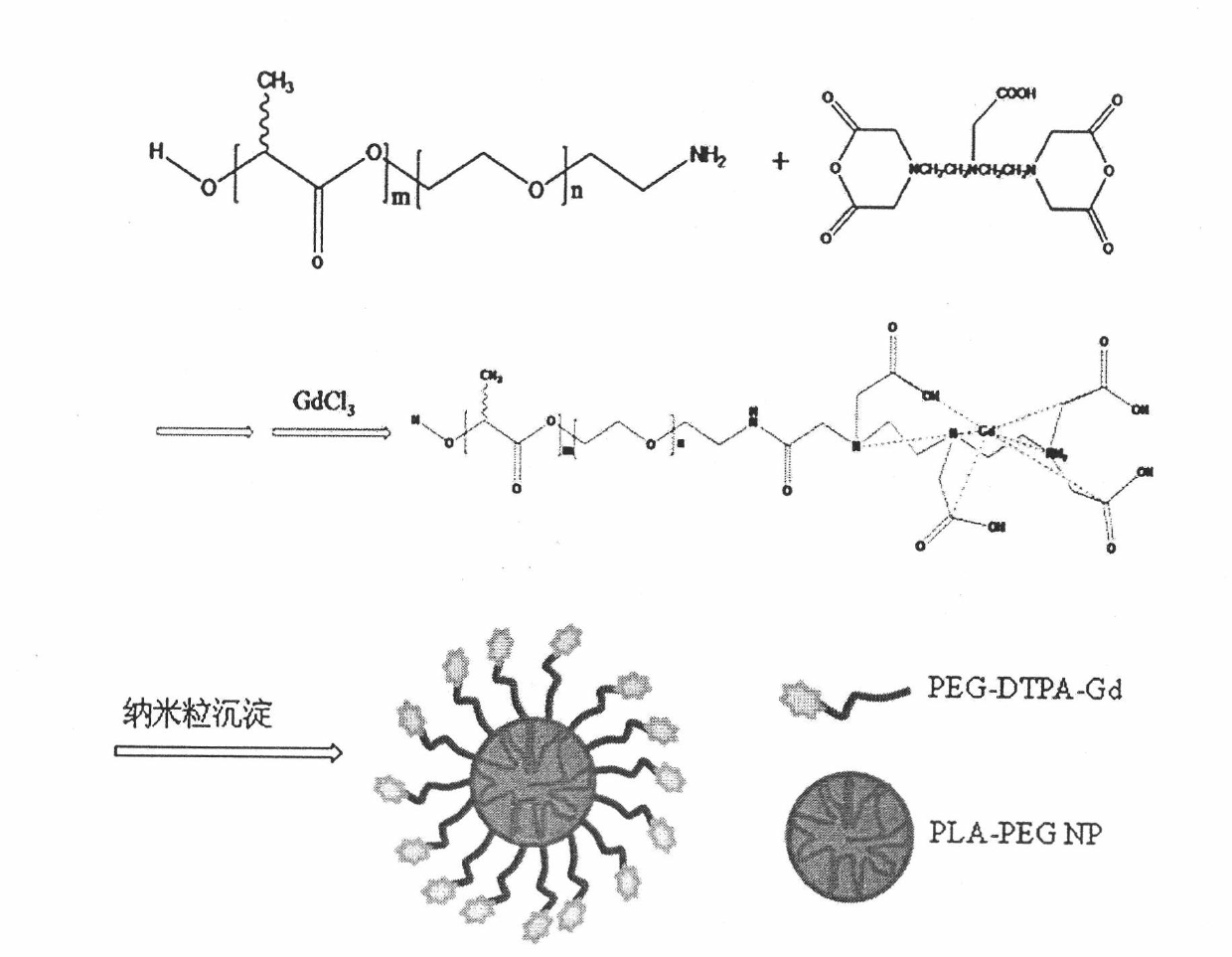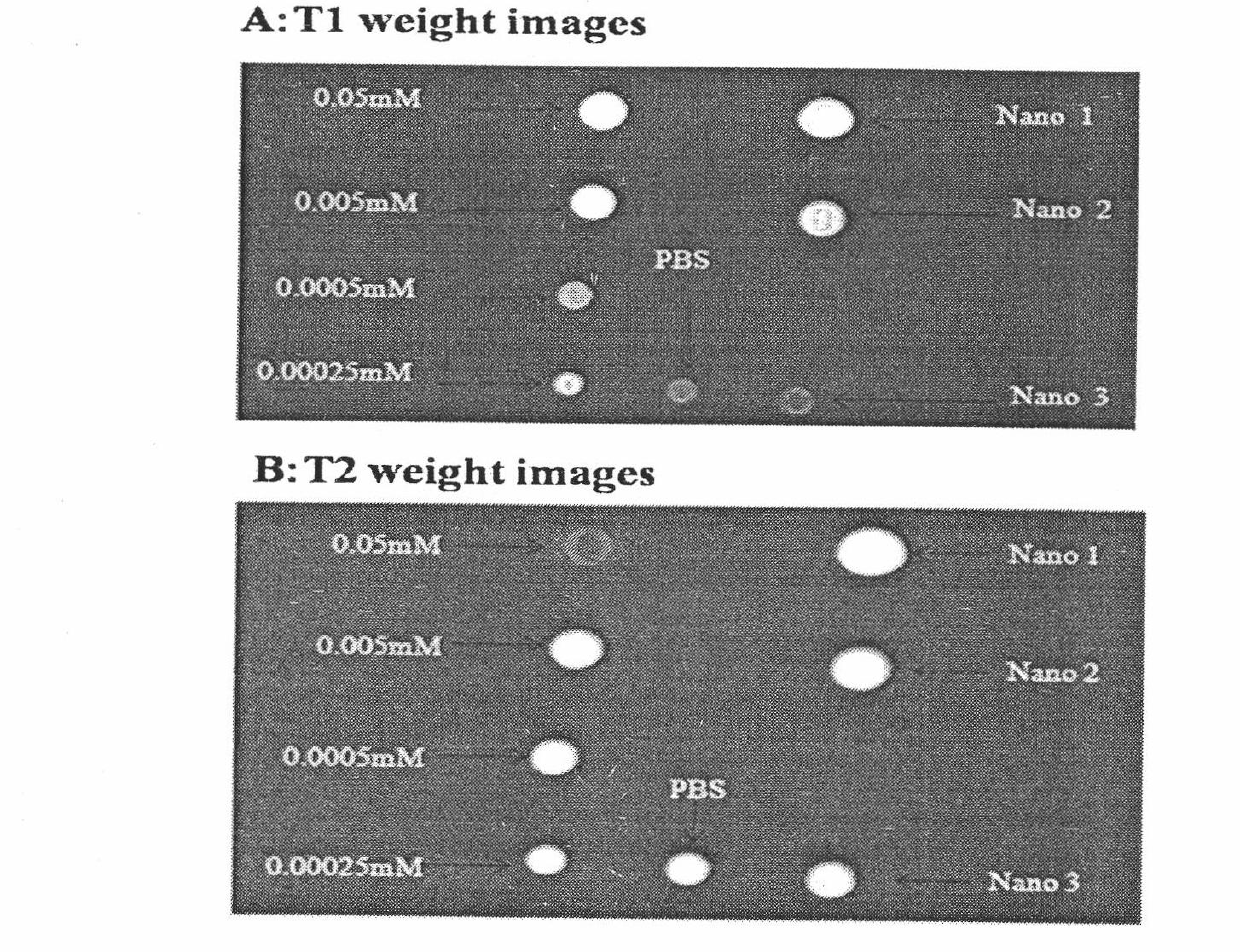Polymer nanoparticle magnetic resonance contrast agent and preparing method thereof
A magnetic resonance contrast agent and nanoparticle technology, which can be used in pharmaceutical formulations, preparations for in vivo tests, etc., can solve problems such as non-characteristics, blood supply characteristics of lesions, and failure to achieve ideal early diagnosis of liver cancer, and increase local Concentration, improve curative effect, reduce the effect of toxic and side effects
- Summary
- Abstract
- Description
- Claims
- Application Information
AI Technical Summary
Problems solved by technology
Method used
Image
Examples
Embodiment 1
[0040] The preparation method of polymer nanoparticle magnetic resonance contrast agent:
[0041] (1) Synthesis of diethylenetriaminepentaacetic acid (DTPA) cyclic anhydride
[0042] React 0.1 mol of diethylenetriaminepentaacetic acid with 0.5 mol of acetic anhydride in 0.7 mol of anhydrous pyridine at 65°C for 24 hours, then filter, wash the solid with anhydrous ether, and dry it in vacuo to obtain a white solid diethylene triamine Aminopentaacetic acid cyclic anhydride;
[0043] (2) Synthesis of diethylenetriaminepentaacetic acid-polyethylene glycol-polylactic acid copolymer (PLA-PEG-DTPA)
[0044] ①PLA-PEG-NH 2 The synthesis of block copolymers adopts an anionic ring-opening polymerization method. Under an argon atmosphere, KHMDS is used as an initiator to initiate ring-opening polymerization of ethylene oxide and lactide in THF at 25°C, and then add acetic acid Terminate the reaction, and add hydrochloric acid to remove the protecting group, use 9mol of ethylene oxide, ...
Embodiment 2
[0051] Preparation of polymer nanoparticle magnetic resonance contrast agent:
[0052] (1) Synthesis of diethylenetriaminepentaacetic acid (DTPA) cyclic anhydride
[0053] React 0.1 mol of diethylenetriaminepentaacetic acid with 0.5 mol of acetic anhydride in 0.7 mol of anhydrous pyridine at 65°C for 24 hours, then filter, wash the solid with anhydrous ether, and dry it in vacuo to obtain a white solid diethylene triamine Aminopentaacetic acid cyclic anhydride;
[0054] (2) Synthesis of diethylenetriaminepentaacetic acid-polyethylene glycol-polylactic acid copolymer (PLA-PEG-DTPA)
[0055] ①PLA-PEG-NH 2 The synthesis of block copolymers adopts an anionic ring-opening polymerization method. Under an argon atmosphere, KHMDS is used as an initiator to initiate ring-opening polymerization of ethylene oxide and lactide in THF at 25°C, and then add acetic acid Terminate the reaction, and add hydrochloric acid to remove the protecting group, use 9mol of ethylene oxide, 0.1mol of i...
Embodiment 3
[0062] In vitro characterization of PLA-PEG-DTPA-Gd nanoparticles of the present invention:
[0063] 1.Gd 3+ Content Determination: It is measured by high-frequency inductively coupled plasma emission spectrometry.
[0064] 2. The results of in vitro imaging of nanoparticles show that PLA-PEG-DTPA-Gd nanoparticles have a significant enhanced imaging function,
[0065] See figure 2 .
PUM
 Login to View More
Login to View More Abstract
Description
Claims
Application Information
 Login to View More
Login to View More - R&D
- Intellectual Property
- Life Sciences
- Materials
- Tech Scout
- Unparalleled Data Quality
- Higher Quality Content
- 60% Fewer Hallucinations
Browse by: Latest US Patents, China's latest patents, Technical Efficacy Thesaurus, Application Domain, Technology Topic, Popular Technical Reports.
© 2025 PatSnap. All rights reserved.Legal|Privacy policy|Modern Slavery Act Transparency Statement|Sitemap|About US| Contact US: help@patsnap.com



